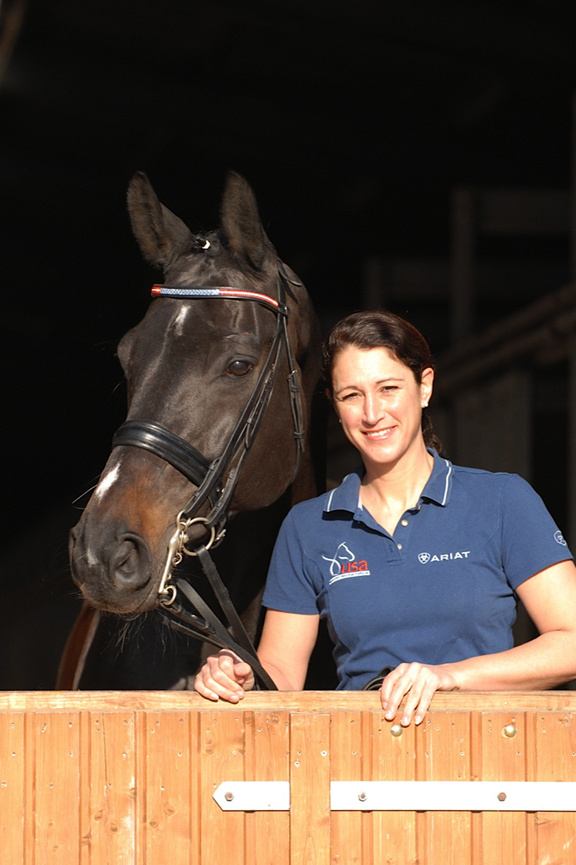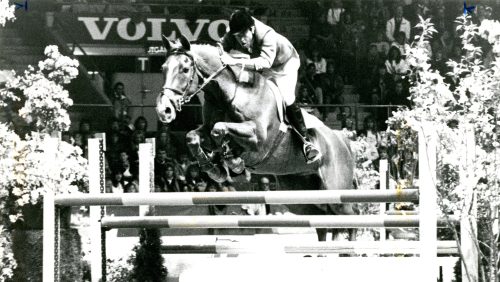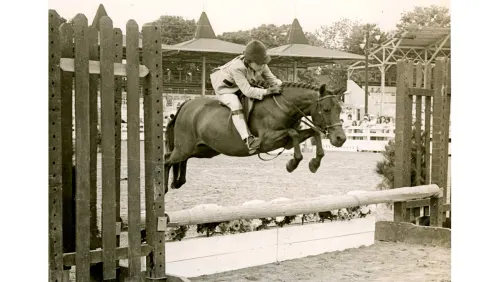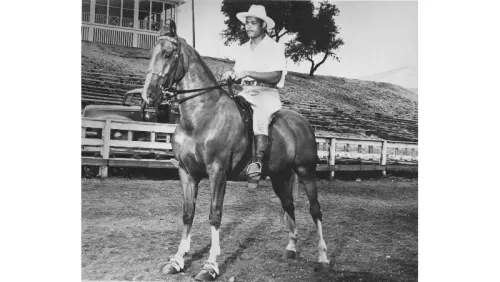
Photo by Julia Wentscher
This blog originally ran in 2011 on COTH.
Dear Rita,
Teaching has been a passion of mine since I began riding horses as a young girl. Nowadays, the more I learn, the more I want to teach. The more I teach, the more I want to learn!
The more I teach, the more I appreciate the students who come to me with a centered, quiet mind, ready to listen, absorb and learn. In fact, I seek them out. I used to believe that giving a good riding lesson was solely my responsibility. I realize now, after many decades of teaching, that a student must also take responsibility for the outcome of their lesson. If a student is not willing to do that, he or she will not be long in my company.
Rita, this is going to be a lengthy piece that contains a lot of information. Let me know if any of the subjects I touch on need more explanation. I could carry on with this subject for hours! I welcome your comments and questions.
I like to teach riders from all levels of the sport. Every successful lesson I have ever taught has involved the improvement of a rider’s basic training—be that in a sitting trot lesson without stirrups, or in training the half-halt to improve self-carriage in passage.
Basics are the mainstream of my training system from pre-training level through Grand Prix.
I had taken a hiatus from teaching during the six years of my sponsorship with the JSS Trust because I had the financial support to concentrate solely on training and competing. Now I am on the road again teaching a lot of clinics, and I am very pleased to have new opportunities to share my knowledge with other riders.
The concept of sharing responsibility for a good riding lesson—50/50 between the student and the instructor—is strong with me now. Perhaps it is time to talk about that!
Let’s start with the instructor.
Being a good instructor has multi-level requirements. Firstly, a good dressage teacher must have an appropriate level of technical understanding for the level of student that rides in front of her/him. If you’re trying to fix problems in the right half-pass without ever having ridden one, you might be in for a bit of a struggle.
Secondly, a good dressage instructor will have an eye for evaluation, analysis and correction. If a rider comes to me for a lesson because she is struggling with pirouettes, I not only need the technical knowledge of how to ride one, but I also must develop the ability to observe her pirouettes with a skillful eye and offer a solution.
1. Evaluation: What is the basic problem with the pirouette? The horse is losing balance.
2. Analysis: Why is the horse losing balance? The rider is sitting too far to the outside and pushing the haunches too far to the inside.
3. Correction: How can I correct this? Begin the pirouette with shoulder-in on the centerline with the rider positioning her upper body more over the inner seatbone.
This threefold approach can only be practiced by an instructor who possesses good technical skill AND the ability to evaluate, analyze and correct.
Thirdly, and perhaps most importantly, the best teachers in the world have a generous spirit. They have stepped into the arena not to show off what they know, but to tell a student what she or he must hear in order to learn. As a student, this is a pet peeve of mine, Rita. I cannot abide an instructor who steps into the arena and tells me everything that is going wrong. This is an ego-based action, and I have no time for it. I KNOW what is going wrong; what I need to hear is how to fix it. A good instructor does not step into the arena to show off, but rather, to HELP.
Effective Instruction Requires An Individualized Approach
Having said that, what a student needs to hear is different for every individual, and if an instructor (especially a clinician) is going to be successful, he/she must have the ability to figure that out in a timely manner.
Let’s say I have Student A, Student B and Student C in a clinic. They are all amateur riders with a good basic seat on well-trained horses capable of third level. All three students are having trouble riding flying changes.
ADVERTISEMENT
Student A needs to hear: “Listen to the timing of the canter. Hear the rhythm of one-and –two, and one-and-two, and one-and-two. Your aid comes on the “AND.”
Student B needs to hear: “Ride counter canter across the half diagonal. At the centerline, stay relaxed and touch his belly with the left spur.”
Student C needs to hear: “Kick him! You’re not asking for a change at all. Your spur never touched his skin. Don’t be afraid of his reaction. He knows his job. So ASK him!”
Now how each of these horses and riders responds to the initial instruction may warrant an adjustment in the approach. This is where a deep base of technical skill comes in handy. And perhaps more importantly, an understanding of how you can get the student to respond in a way that helps them learn.
Some people require overwhelmingly positive reinforcement. Others need sharp, quick commands. Some need to be pushed. Some need psychological support for their fear. Others just need a simple exercise to show them where they have gone wrong.
The student’s level of knowledge often plays a factor in how they learn. Casey Dornan-Nilsson came to me as a medium level rider 15 years ago. She now professionally trains and shows the horses in my stable. Fifteen years ago, she needed to learn a lot of technical things (like how to count the flying changes). Today, she is still learning technical stuff (like how to speed up the piaffe) but she learns at an incredibly rapid pace now compared to 15 years ago. That is to be expected.
What has been consistent over the years is that Casey has always learned from FEEL, and she has always learned AFTER the lesson—when I’m not watching her anymore. I have to find ways to make her feel the things I want to see changed, and then I have to go away to let her learn it while I am not watching. This was not a comfortable process for me in the beginning, but it functions well for us now. A few words or a short demonstration are usually all she needs to get started. I look up from a concentrated ride a few days later and viola!—there is the picture I want to see.
Interestingly enough, Casey learns in present time when being taught by Morten Thomsen, my own trainer. I tend to learn more from Morten the day after he is gone. This just goes to show you that the relationship between each instructor and student will function in various and mysterious ways!
Of course, when you have 15 years with the same student, you have the luxury of taking your time to figure out how they learn from you. A clinic situation is time sensitive, and the difference between a good and bad clinician is how quickly one can determine what works for each student. This is a challenge that I personally relish.
Tips For Being A Good Instructor And Clinician
- Improve your technical skill at every opportunity.
- Observe riders who are better than you are.
- Observe teachers who are better than you are.
- Find a way to improve your concentration skills. Anybody can give 10 riding lessons in a day. Very few people are focused enough to give 10 GOOD riding lessons!
- Step into the arena to offer guidance, not to show your own knowledge.
- Keep it simple. Correct one thing that is possible to correct in the moment. The next step will be obvious after that.
- Do the best job that you can and then detach yourself from the outcome. The rest is up to the student.
The Student’s Responsibilities
Now let’s turn to the responsibility of the student. The first thing you should do as a student is SHUT UP AND RIDE. (LOL! I am not kidding, Rita!) Let the instructor do his/her job without your guidance.
Here are some scenarios you might want to avoid if you are willing to take some responsibility for your own success in a riding lesson:
1. Don’t talk when someone is trying to teach you. You can’t actually LEARN while talking.
Example: Student A tries to do a right canter depart from walk. When she puts her left leg back, the horse swings the haunches out and comes simultaneously against the outside leg and against the hand. The rider tries to correct this by pushing with the left leg but the horse just tosses his head and swings his haunches more into that leg.
I say: “You should bend him right in that moment.” Bending the horse to the right, which requires use of the RIGHT rein and leg, breaks up the resistance the horse is offering to the right rein (the actually crux of the problem) and puts the horse in a position to move his haunches away from the left spur when the bend created under the saddle follows through to the hindquarters.
But rather than bend the horse to the right, the rider snaps: “I am trying to get him to move away from my left leg right now!”
I know of course what you are trying to do. I’ve just offered you a solution, but you didn’t hear it because you want to tell me what I already see. Center yourself. Listen. Try to do what I am telling you. Learn the solution. In a moment of correction, there is not time for lengthy explanation. Learn by making the right correction, not by telling your instructor what she already sees.
2. Don’t blame the horse unless your basics are flawless.
Most horses do what they are told to do. If you are giving correct aids and you are not getting what you ask for, there are ways to convince the horse to be more generous. But ask correctly first!
ADVERTISEMENT
Example: Student B crosses the half diagonal on the left lead. When she reaches the track, she asks for a flying change by putting the left leg back and presses with it so unfeelingly that the horse actually goes in counter canter with the haunches to the inside, but doesn’t make a flying change. (This is impossible to do if you actually intend to do it, but I saw a student create this very scenario a few weeks ago!!) The rider yells over her right shoulder, “I am asking and he is not doing it!” as she rides down the long side in haunches in/counter canter, pressing firmly with the left leg….
In reality, this rider was getting exactly what she asked for, so we had to go over the flying change aids again. When asked properly from a light tap of the spur reinforced by a tap of the whip so that there could be no misunderstanding, the horse did the flying change. Be honest with yourself. If your technical skill is not highly developed, don’t assume that your horse is making mistakes.
3. Be respectful.
If you have hired someone to teach you, do not question their method without first giving it try.
Example: Student C wants to know how to correct her passage to piaffe transition. She shows it to me. I say: “Do it again and this time put your leg forward and tap him near the girth with your spurs right after the transition.”
She responds with, “I’ve been taught to put my leg back in the transition.”
So she does it her way again to show me what she knows rather than trying to learn what I am teaching her.
Now, this lady’s horse falls on the forehand in the transition to piaffe because she crams her lower leg back on the barrel and tips forward on her seatbones while pulling the head down in a tight frame. She needs to put her own weight on the back of her seat bones, tap the horse nearer to the girth with her spurs so that he will lift his withers, and allow him to lift his poll by giving with her hand.
I don’t explain this yet. I repeat, “Do it again, and this time put your leg forward and tap him near the girth with your spurs right after the transition.”
She stares at me and then shrugs. Then she does what I tell her to do, and after she comes into the transition to piaffe with her leg more forward, I say, “Now give on the reins.”
She stops and says, “I’ve been taught to keep the same contact between piaffe and passage.” So I repeat, “Give on the reins in the piaffe.” She tries again, this time with the spur at the girth, which drops her back on her seatbones and starts to elevate the horse’s withers. When she gives on the reins his nose comes to the vertical and his poll is at the highest point. He lifts his front legs more. The transition and the piaffe have improved by two marks. She gets it! I smile.
Then she asks me, “Why have I been taught incorrectly?” Big sigh. Dressage is a transformative sport. We take different approaches with our horses as they learn and progress. So be respectful of past and new knowledge.
Now, with any one of these scenarios, if the student had just NOT SPOKEN and instead tried to do what she was told, she would have been further along in correcting the mistakes in a shorter amount of time. I could have taken the time to explain all the tiny details of every correction, but the rider ALWAYS learns more if he or she actually does it first and receives the explanation afterward. Do it first, talk second. If you talk first, the momentum and impulsion you need to achieve your goal are already lost.
When in doubt, keep your mouth shut and your ears open!
More Tips For Being A Good Student
- Don’t bring the frustrations of your daily life with you to your lesson. Let them go at the entrance to the arena. Your riding instructor is there to help you with your riding, not your marriage, divorce or stress-related problems.
- Be on time.
- Be prepared for the lesson. Are you in shape? Is your horse fit?
- Work on your mental focus. This is a large part of preparation.
- Don’t blame the horse when things go wrong.
- Don’t blame the instructor when things go wrong.
- Learn to correct technical issues—why they happen is not important.
- Be respectful. Don’t tell the teacher how to teach you or what you need to learn. A good one will see these things immediately.
Rita, I have been both a student and a teacher my whole life. I cannot completely separate one from the other, but I can tell you that as I progress and learn as a dressage rider, this sport continues to fascinate me every day.
I’m Catherine Haddad, and I’m sayin’ it like it is from Vechta, Germany.
Training Tip of the Day: Can you begin a riding lesson (as a student or a teacher) with a clear mind and maintain that state throughout the lesson?














